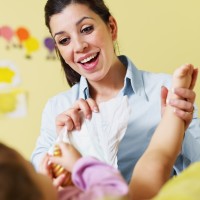Written by Sheena Jennings, Unit Supervisor, Mecklenburg County CDSA
At the Mecklenburg County CDSA in Charlotte, NC, we have been on a journey over the last few years to implement Natural Learning Environment Practices. M’Lisa Shelden, PT, PhD and Dathan Rush, EdD, CCC-SLP presented a refresher training for our staff and community providers this month. The air in the room was much ‘lighter’ than when the journey began almost 5 years ago. This time, I could see heads nodding in agreement and hear comments from participants about how they have worked to incorporate the evidence-based practices we were discussing into their work with families and children.
A point made during the training that particularly caught my attention this time was to consider playfulness within naturally occurring family activities, versus families feeling like they have to carve out extra time in the day to play and work on development or building skills. Often, early intervention providers enter into sessions with the families with ‘play’ as the primary activity setting. We all know that “play is the work of children,” so what could be wrong with this approach? Focusing all early intervention sessions on play can prevent us from supporting families in the many other routines and activity settings that they are participating in each day. Also, many families interact with their children in different ways other than sitting on the floor and “playing.” For example, for infants and toddlers, the activity setting of diaper changes happens many times during a day. The parent and other caregivers can incorporate playfulness and learning opportunities (such as playing peek-a-boo, introducing words about diapering in a sing-song voice, or socially engaging with kisses or tickling) into that activity instead of feeling pressure to set aside additional playtime to work on language skills. An excellent blog on this topic was published by Virginia’s Early Intervention Strategies for Success Blog – What If You Didn’t PLAY with Toys on Your Next Visit?
The concept of Playfulness vs. Play is important as we consider the approach for natural learning environment practices. During the training, we focused on the following Characteristics of Natural Learning Environment Practices (Family, Infant & Preschool Program – Morganton, NC – September 2014):
- Activity Setting – Schedule visits to occur during an actual child, family or classroom activity or routine. Use the actual activity or routine at the time of the visit as context for intervention and part of the joint plan for between visits.
- Example – Naptime is difficult for the parent when helping the child transition to the crib and settle in for rest. The early intervention provider schedules the visit to coincide with nap time and coaches the parent through the transition.
- Child Interest – Use actual activities or routines based on child interests that occur at the time of the visit as context for the intervention and part of the joint plan for between visits. Support the parent or teacher in using the child’s interests to promote participation in the activity.
- Example – Water is a high interest area for the child. The early intervention provider comes right after lunch and coaches parent and child during the activity on how to build language and promote self-help skills while they are washing dishes.
- Parent/Caregiver Responsiveness – Actively engage or follow parent/teacher lead in the activity or routine. Support the adult in fostering child participation to help the adult’s interaction match the child’s. Intentionally model or teach new interaction strategies (if needed) to promote the child’s participation.
- Example – The child does not come over to participate in circle time in the classroom. The teacher’s strategy is to no longer invite the child over to participate due to negative responses in the past. The early intervention provider attends session just before circle time to coach teacher on new ways to engage the child in circle time activities that fits the child’s interest and ability.
As the trainers reminded us, “some families don’t play together, but everybody eats, sleeps, and poops”. So how can we support families to be “playful” in their interactions during typical routines and activities to promote relationships and child learning and avoid always choosing “play” as an activity setting for intervention sessions?
As you think about your practices with families and children consider the following:
- Do family’s IFSPs help us know about the family activity settings and child interests? Do IFSP outcomes incorporate other family routines besides play?
- Ongoing, how do you collect information about activity settings and child’s interests and share this knowledge with other IFSP team members?
- If this is not your practice, how do you begin to implement these concepts, and what support do you need?
On February 3, 2015 we will be coming back together to learning more about – Coaching in Natural Learning Environments. Stay tuned for a recap of this training.






No comments yet.